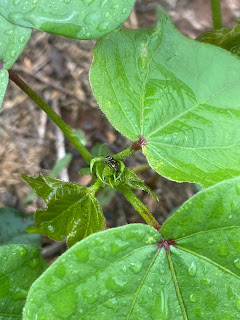Several cotton insects presented unique or unusual infestation patterns in 2021. The following is a discussion of insects as they occurred during the season and what we may want to consider as we enter the 2022 crop year.
 |
| Cotton seedlings showing varying thrips injury in 2021. |
Thrips, for the second season in a row, reached their peak injury period in late May to early June. Therefore, the heaviest damage was to cotton planted after about May 10-15. Growers should be alert and protect all seedlings from thrips injury until plants reach about the 5th true leaf. This can be done by applying a timely foliar spray when seedlings are at the 1st true leaf. The Thrips Predictor
Model, developed by NC State with research data from all Southeastern states, is very useful in alerting to potential injury in this late planting window, especially when it is run weekly until all seedlings are safe from injury. This phenomenon of thrips damage on late planted cotton is likely driven by frequent rainfall in the early to mid-planting window. Excessive rainfall tends to sustain and keep lush wild host plants that harbor thrips, thus delaying their movement to cotton.
 |
| Plant bug infesting 7 node cotton in Belle Mina, AL in 2021 |
A second pest that presented an
unusual infestation pattern last year was
tarnished plant bug. A heavy, statewide
movement of adult plant bugs from wild hosts to cotton occurred between June
13-15. Reports and observations about plant bug migration came from Central
Alabama, Tennessee Valley, Gulf Coast and Wiregrass during this 72-hour period.
This movement, had it been from one specific area, would have been expected,
but the fact that it occurred statewide within a short time had never before
been observed or reported. All available media, social, electronic and
telephone hotline, were employed to alert agents, field advisors and farmers.
These early season adult plant bugs immediately began feeding in young squaring
cotton, causing pinhead square loss in the early fruiting window. At the same
time, female adults were depositing eggs into the tender stems of cotton,
producing a hatch of immature plant bugs 3 weeks later in cotton between weeks
1 and 3 of bloom. Where timely controls were not made, “dirty” blooms resulted,
and yields were reduced.
 |
Stink bugs can cause damage until bolls are ~25 days old.
|
One other insect,
stink bugs,
should be part of this discussion. Stink bugs were more numerous than expected
last season following what we thought was a colder than normal winter,
including a particularly cold week that occurred in mid-February. We realize
that though stink bugs have been our number one most damaging insect in cotton
for the past 25 years, we are still refining or fine tuning our control
strategies. One observation made in 2021 was that mid to full season varieties
may require an additional late season application as compared to early maturing
varieties. Basically, stink bug controls are warranted until the uppermost
bolls – top bolls that are expected to be harvested – are about 25 days old and
hard to the touch. During boll fill, a stink bug application should give about
2 weeks control or suppression except in field borders adjacent to corn,
peanuts, pecans or other alternate stink bug hosts. After stink bugs enter
cotton, beginning about the 3
rd week of bloom, any applications
targeting plant bugs should include an insecticide or tank mixture that
controls both pests.
Take Home Point:
The take home message from these occurrences is that growers and other ag advisors must be aware of more than
just what they see in local fields. They must be “in the loop” from a bigger
perspective in order to be alerted to unusual insect outbreaks. The Alabama
Extension Cotton Entomology team has lots of eyes and ears throughout the state
and receive daily and weekly feedback that can be passed along to all involved.


